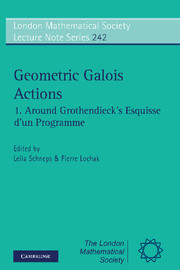Book contents
- Frontmatter
- Contents
- Preface
- ESQUISSE D'UN PROGRAMME
- Esquisse d'un Programme
- Brief an G. Faltings
- Grothendieck's “Long March through Galois theory”
- The algebraic fundamental group
- Etale homotopy type of the moduli spaces of algebraic curves
- The ‘obvious’ part of Belyi's theorem and Riemann surfaces with many automorphisms
- Glimpses of Grothendieck's anabelian geometry
- Some illustrative examples for anabelian geometry in high dimensions
- The fundamental groups at infinity of the moduli spaces of curves
- Galois representations in the profinite Teichmüller modular groups
- Deux lettres sur la cohomologie non abélienne
- The Grothendieck-Teichmüller group GT: a survey
- Approximating Galois orbits of dessins
- Tame and stratified objects
- Sketch of a Programme (translation into English)
- Letter to G. Faltings (translation into English)
The ‘obvious’ part of Belyi's theorem and Riemann surfaces with many automorphisms
Published online by Cambridge University Press: 05 April 2013
- Frontmatter
- Contents
- Preface
- ESQUISSE D'UN PROGRAMME
- Esquisse d'un Programme
- Brief an G. Faltings
- Grothendieck's “Long March through Galois theory”
- The algebraic fundamental group
- Etale homotopy type of the moduli spaces of algebraic curves
- The ‘obvious’ part of Belyi's theorem and Riemann surfaces with many automorphisms
- Glimpses of Grothendieck's anabelian geometry
- Some illustrative examples for anabelian geometry in high dimensions
- The fundamental groups at infinity of the moduli spaces of curves
- Galois representations in the profinite Teichmüller modular groups
- Deux lettres sur la cohomologie non abélienne
- The Grothendieck-Teichmüller group GT: a survey
- Approximating Galois orbits of dessins
- Tame and stratified objects
- Sketch of a Programme (translation into English)
- Letter to G. Faltings (translation into English)
Summary
Introduction.
Many articles on Grothendieck dessins, Belyi functions, hypermaps on Riemann surfaces etc. have at least in part the character of survey articles or give new access to old material. The reasons for this phenomenon are the rapidly growing interest in the subjects, the non–existence of monographs as common source and reference, and the very different mathematical or physical origins of the people working in this field. Moreover, there are a lot of facts and interrelations in principle well known to experts but often not stated or proved before as explicitly as needed. The present article again belongs to this category of papers and tries to shed new light on some old subjects and to make their connection visible. The first subject is the well–known result of Belyi [Be]:
Theorem 1.A compact Riemann surface X is isomorphic to the Riemann surface C(ℂ) consisting of the complex points of a nonsingular protective algebraic curve C defined over a number field if and only if there is a non-constant meromorphic function β on X ramified over at most three points.
Such functions will be called Belyi functions. Of course we may assume that they are ramified over the three points 0, 1 and ∞. The surprisingly simple algorithm found by Belyi to prove the ‘only if’ part of the theorem is reproduced in many later papers and will not be discussed here, we will care about the ‘if’ part only.
- Type
- Chapter
- Information
- Geometric Galois Actions , pp. 97 - 112Publisher: Cambridge University PressPrint publication year: 1997
- 21
- Cited by

